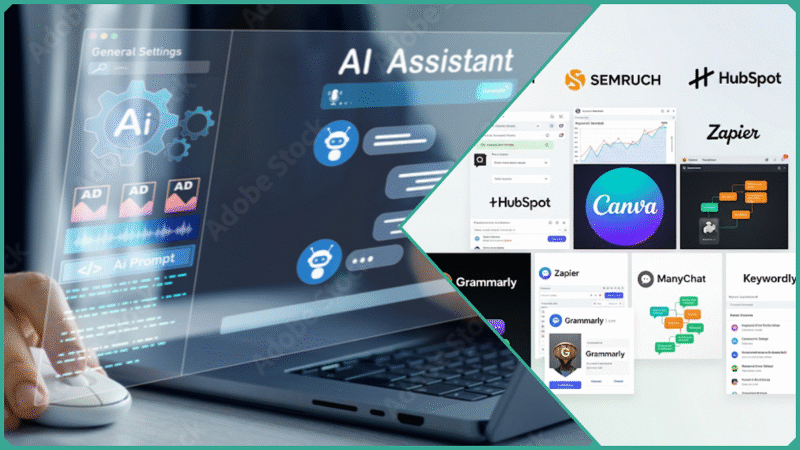Top 9 AI Tool to Develop Software Without Coding Knowledge
Estimated reading time: 19 minutes
Millions of entrepreneurs, small business owners, and professionals with brilliant ideas face a common obstacle: how to develop software without coding expertise. Whether it’s building a custom app for the business, creating internal tools to automate workflows, or launching a side hustle, traditional software development is costly, slow, and often demands technical know-how that non-developers lack.
Thankfully, 2025 marks a turning point with the rise of innovative AI-powered no-code tools that enable anyone to develop functional software without writing a single line of code. These platforms leverage artificial intelligence to drastically simplify the creation process, reducing time, cost, and reliance on scarce developer resources.
They empower non-technical entrepreneurs, citizen developers, and individuals pursuing side hustles to transform their ideas into reality and validate their concepts rapidly and effectively. By providing accessible tools and resources, they enable users to bring their innovative visions to life with ease and speed, helping them test and confirm their ideas quickly to accelerate growth and success.

This post is designed to be your ultimate go-to resource to develop software without the need for traditional coding by carefully presenting the top 9 most effective and innovative AI tools available today that can help you achieve this goal efficiently.
Each tool will be thoroughly explained, highlighting its unique features, advantages, and potential drawbacks. Additionally, practical examples will be provided to give you clear, hands-on insights. This comprehensive approach is designed to help you confidently and efficiently jumpstart your software development journey with a solid understanding of each tool’s capabilities and best use cases.
Understanding AI-Driven No-Code Development
AI-driven no-code development platforms combine intuitive, visual, and user-friendly interfaces with powerful artificial intelligence enhancements, making the process of software creation significantly easier and more accessible for users who do not have technical programming skills or coding experience.
- No-Code Development platforms empower users to create software applications without the need for traditional programming languages by utilizing intuitive graphical interfaces, drag-and-drop components, and a wide range of pre-built templates. This innovative approach significantly democratizes the process of software creation by eliminating the requirement to manually write complex code, thereby making application development more accessible to individuals who do not have formal technical expertise or coding skills. As a result, a broader audience, including business professionals and creative individuals, can participate in building functional software solutions.
- AI-Powered Enhancements significantly augment these platforms by automatically generating a wide variety of code snippets, providing insightful design and workflow suggestions, anticipating the evolving needs of users, and optimizing both the performance and overall user experience of applications. The integration of artificial intelligence dramatically reduces the complexity of many development tasks, effectively streamlining the processes of prototyping, iterative testing, and final deployment. Furthermore, AI accelerates development cycles by enabling the visual configuration of sophisticated AI models, supporting automated decision-making processes, and facilitating the seamless integration of advanced machine learning features—all achievable without the need for traditional coding skills.
Together, no-code and AI form a powerful synergy that lowers barriers to software creation, increasing accessibility, reducing time and costs, and empowering a broader audience—including business users, citizen developers, and entrepreneurs—to quickly transform ideas into functional software solutions. This democratization fosters innovation, agility, and collaboration across industries and job roles.
In Summary
AI-driven no-code development platforms empower users to harness advanced AI technologies through user-friendly, intuitive visual tools, enabling the rapid, cost-effective, and highly scalable creation of software applications without requiring any prior programming knowledge or coding skills.
This transformative trend is significantly reshaping the traditional landscape of software development and expanding the pool of who can actively participate in building digital solutions, making it an indispensable strategy for businesses and individuals striving to innovate quickly and efficiently in today’s fast-evolving digital economy.
Current Trends in AI No-Code Software Development
Current trends in AI no-code software development in 2025 reveal a significant and transformative shift in the way software is designed, created, and deployed across a wide range of industries. This evolution is reshaping traditional development processes by enabling faster, more accessible, and highly efficient software solutions tailored to diverse business needs and user capabilities.
Widespread Adoption Across Various Sectors
An increasing number of companies across multiple industries are embracing no-code platforms as a strategic approach to deliver advanced automation and create bespoke software solutions. This is achieved without the need to expand or heavily invest in their existing IT teams, allowing for greater flexibility and faster deployment.
According to Gartner’s latest predictions, by the year 2026, an estimated 70% to 75% of all new enterprise applications will be developed using low-code or no-code technologies. This significant forecast highlights the growing and mainstream acceptance of these platforms as essential tools for modern business innovation and digital transformation.
AI-Assisted Design, Content, and Workflow Automation
The integration of AI significantly enhances no-code platforms by not only automating design suggestions but also by generating high-quality content and streamlining complex workflow automation processes.
Advanced features such as AI-powered debugging tools, predictive recommendations based on user behavior, and intelligent decision-making automation contribute to improving overall software quality. These capabilities collectively help to accelerate development cycles, reduce errors, and enable developers and users to create more sophisticated applications with greater efficiency and ease.
Focus on Diverse Application Types
No-code AI tools have become essential across a wide range of application types, including mobile app development, web-based applications, internal business portals, and e-commerce platforms. These versatile tools enable developers and non-developers alike to engage in rapid prototyping and seamless deployment of both customer-facing solutions and internal-use software.
By eliminating the complexities traditionally associated with manual coding, no-code AI platforms significantly accelerate the development process, allowing businesses to quickly adapt to changing market demands and enhance user experiences across multiple digital environments.
Seamless Integration Capabilities
Modern platforms now provide a wide range of extensive API, databases, and third-party service integrations that do not require developers to write any code. This robust connectivity significantly enhances overall functionality and enables applications to effortlessly interact with a variety of systems such as CRM platforms, payment gateways, cloud storage services, and many other external tools.
As a direct result, the overall usefulness and versatility of no-code applications are significantly expanded and enhanced, enabling users to create and build much more complex, sophisticated, and interconnected solutions with remarkable ease and efficiency.
Empowerment of Citizen Developers
The democratization of software development is revolutionizing the way organizations operate by enabling professionals across various departments, such as marketing, HR, sales, and many others, to create their own customized applications.
These citizen developers leverage no-code AI tools to automate repetitive and time-consuming tasks, tailor workflows to meet their unique needs, and address specific challenges within their departments without relying on IT support. This shift not only fosters innovation at every level but also significantly accelerates overall business agility and responsiveness in a rapidly changing market environment.
Hybrid Development Models
The current trend increasingly favors combining no-code tools with traditional coding practices, resulting in hybrid development models that leverage the strengths of both approaches. This methodology employs no-code platforms primarily for rapid prototyping and streamlining business process automation, allowing teams to quickly iterate and validate ideas.
Meanwhile, more complex or performance-critical features continue to be custom-coded by experienced professional developers to ensure robustness and scalability. By blending these two strategies, organizations can optimize the use of available resources, accelerate innovation cycles, and deliver high-quality software solutions more efficiently.
Emergence of Natural Language Programming (Vibe Coding)
An exciting and rapidly growing new trend in the technology world allows both developers and non-developers alike to create fully functional software applications using simple natural language instructions powered by advanced AI models.
This innovative approach significantly lowers the traditional technical barriers that have long separated coding experts from beginners, enabling a much wider range of people to participate in software creation. By leveraging conversational AI interfaces, this method not only makes the process more intuitive but also greatly accelerates the pace of software development, transforming the way we build and interact with technology.
In Summary
The AI no-code software development landscape in 2025 is marked by a significantly accelerated rate of adoption, where more businesses and individuals are embracing these tools at an unprecedented pace. This environment is further enhanced by AI-driven creativity and automation capabilities that empower users to design and build applications with greater ease and sophistication.
The incredible versatility of no-code platforms enables users to create a broad and diverse range of applications, spanning from simple, straightforward tools to highly complex and sophisticated systems, effectively catering to a wide variety of business needs and requirements across different industries.
Additionally, these platforms offer deep integrations with other technologies and services, ensuring seamless workflows and enhanced functionality. Importantly, the increased inclusion of non-technical users in the software development process fosters a democratization of technology, enabling a broader audience to participate actively in software creation.
Together, these trends drive improved efficiency, spark innovation, and provide greater flexibility, perfectly aligning with the evolving requirements of modern businesses striving for rapid and successful digital transformation initiatives.
Top AI Tools to Develop Software Without Coding Knowledge
Gone are the days when building software was an exclusive skill reserved for programmers. The rise of artificial intelligence has completely democratized the process, empowering anyone with a great idea to bring it to life without writing a single line of code.
From mobile apps to internal business tools, AI-powered platforms are doing the heavy lifting, allowing you to focus on strategy and design. To help you get started, we’ve compiled a list of the top AI tools that are revolutionizing software development for non-programmers.
BuildFire AI
BuildFire AI is the fastest and easiest AI-driven no-code mobile app builder available today, designed to simplify the app creation process for users of all skill levels. By leveraging sophisticated artificial intelligence technology, it can quickly generate highly customized mobile applications tailored specifically to meet your unique business needs and objectives, saving you valuable time and effort.
- Use case: Perfectly suited for entrepreneurs or small business owners who are looking to quickly launch iOS or Android applications without needing any prior design experience or coding skills. This solution enables users to bring their app ideas to life rapidly and efficiently, making it an excellent choice for those who want to enter the market swiftly without the usual technical barriers.
Features:
- AI-generated app content and feature suggestions.
- Automatic branding matching using website logos and color schemes.
- One-click redesigns for infinite iterations.
- Backed by an industry-leading platform powering over 10,000 apps.
Pros:
- Extremely user-friendly with minimal setup.
- Fast turnaround for app prototypes and launch-ready products.
- Affordable compared to hiring developers.
Cons:
- Mostly limited to mobile apps; less suited for complex custom software.
- Subscription pricing might scale with added features or users.
Example: A local boutique owner successfully launched a fully customized shopping app in less than a week by using BuildFire AI. This rapid development process significantly boosted customer engagement and dramatically increased sales, all achieved without the need for any outsourced development or additional external resources.
Adalo
Adalo is an innovative no-code platform designed for building both web and mobile applications. It seamlessly combines the ease of drag-and-drop functionality with advanced AI-powered automation features, making app development accessible and efficient for users of all skill levels.
- Use case: Ideal for creators who are looking for intuitive and user-friendly visual design tools combined with advanced AI capabilities, including seamless database integration and powerful workflow automation features that enhance productivity and creativity.
Features:
- Visual interface for app design.
- AI-powered logic builder for workflows.
- One-click deployment to app stores.
- Integrations with various APIs and custom databases.
Pros:
- Flexible for a range of apps from simple to moderately complex.
- Strong community and learning resources.
- Generous free trial and affordable paid plans.
Cons:
- It can involve a learning curve for advanced features.
- Limited scalability for enterprise-level demands.
Example: A marketing consultant developed a comprehensive client project management dashboard application designed specifically to streamline communications and track important milestones more effectively, resulting in a significant increase in overall efficiency by 40%.
Bubble
Bubble is a powerful and versatile no-code web application builder that is enhanced with advanced AI features. These intelligent capabilities significantly simplify complex backend workflows, streamline database management, and enable the creation of fully responsive web designs with ease and efficiency.
- Use case: This solution is particularly well-suited for entrepreneurs who are looking to develop functional web applications or minimum viable products (MVPs) that involve complex data interactions, yet who do not possess any prior programming experience or technical background. It allows these individuals to create sophisticated digital products without needing to write code themselves.
Features:
- Drag-and-drop editor with AI-powered pre-built templates.
- Dynamic database creation and management.
- Visual workflow builder automating app processes.
- API connector for third-party service integrations.
Pros:
- Highly customizable for diverse business needs.
- Strong developer community and plugin ecosystem.
- Good educational materials for beginners.
Cons:
- Complexity may overwhelm true novices.
- Performance can vary depending on app design.
Example: A solopreneur developed a fully customized event booking platform using Bubble, effectively replacing the tedious manual tracking process with a seamless system for automated scheduling and payment processing. This innovation significantly improved efficiency and streamlined the entire booking experience.
Appgyver
Appgyver is a highly comprehensive no-code platform specifically designed to cater to enterprise-grade mobile and web application development. It offers a wide range of powerful tools and features, enhanced significantly by AI-driven usability improvements, making the app creation process faster, more intuitive, and accessible to users of varying technical expertise.
- Use case: Ideal for businesses of all sizes that require secure and scalable custom applications but do not have the in-house coding expertise or resources to develop them independently. This solution is particularly well-suited for organizations looking to implement tailored software quickly while maintaining high security standards and the ability to expand as their needs grow.
Features:
- Visual builder interface with logic flows.
- AI-powered debugging and suggestions.
- Wide integration options.
- Supports offline capabilities.
Pros:
- Zero cost for indie developers and small teams.
- Rich feature set suitable for complex apps.
- Enterprise support and scalability.
Cons:
- Steeper learning curve for advanced customization.
- May require technical input for complex API integrations.
Example: A small logistics company developed and implemented an internal delivery tracking application specifically designed to replace the traditional paper forms they had been using. This digital solution significantly enhanced the accuracy of delivery records and ensured that data was readily accessible to all relevant departments, leading to improved overall efficiency and operational transparency.
Wix ADI (Artificial Design Intelligence)
Wix ADI utilizes advanced artificial intelligence technology to design and build fully functional websites and web applications automatically, tailored specifically to the unique preferences and needs of each user. This innovative tool is especially ideal for individuals who do not have technical skills or experience in web development, making the process of creating a professional online presence simple and accessible to everyone.
- Use case: Ideal for small business owners who need to establish an online presence quickly and efficiently, with essential app-like features seamlessly integrated to enhance user experience and functionality. This solution is perfect for those looking to launch their digital footprint without delay while maintaining basic interactive capabilities.
Features:
- AI-driven website and app design.
- Drag and drop customization.
- Pre-built business app modules.
- SEO optimization and marketing tools.
Pros:
- Extremely easy to use with no tech skills needed.
- Fast setup with professional designs.
- Built-in marketing and analytics tools.
Cons:
- Limited to relatively simple web app structures.
- Less flexibility for custom business logic.
Example: A fitness trainer successfully launched a comprehensive booking and client management website using Wix ADI, which allowed them to streamline their scheduling process and attract new client leads much more quickly than they had previously experienced.
Voiceflow
Voiceflow is an innovative no-code platform specifically designed to help users create voice applications and conversational AI interfaces with ease. It offers a variety of AI-driven design tools that simplify the development process, allowing both beginners and professionals to build sophisticated voice experiences without needing to write any code.
- Use case: Ideal for innovators and creators who are developing advanced voice assistants, chatbots, or interactive voice response (IVR) systems without the need for any programming knowledge or coding skills. This solution empowers users to build sophisticated conversational interfaces quickly and easily.
Features:
- Visual conversation flow builder.
- AI-powered natural language processing.
- Multi-platform deployment (Alexa, Google Assistant).
- Prototyping and user testing tools.
Pros:
- Tailored to conversational AI use cases.
- Collaboration-friendly interface.
- Robust integration options.
Cons:
- Niche focuses on voice/AI apps.
- Some aspects require an understanding of conversation design.
Example: A small business successfully automated its customer FAQ handling by developing a custom Alexa skill using Voiceflow. This innovative solution significantly reduced the time spent on support inquiries, saving the company several hours each week and improving overall customer service efficiency.
Thunkable
Thunkable is a user-friendly drag-and-drop no-code app builder platform that seamlessly integrates advanced AI technology to provide intelligent assistance. This AI helps users by offering smart component suggestions and optimizing data workflows, making the process of creating mobile and web applications much more efficient and accessible for everyone, regardless of coding experience.
- Use case: Perfectly suited for educators, students, and hobbyists who are looking to build fully functional and efficient cross-platform applications quickly and with ease. This solution enables rapid development, making it an excellent choice for those aiming to create versatile apps that work seamlessly across multiple platforms without delay.
Features:
- Visual programming interface.
- AI suggestions for layout and logic.
- Real-time testing on devices.
- Wide component and API integration.
Pros:
- Cross-platform publishing (iOS, Android, Web).
- Supports real device preview/feedback.
- Strong educational focus and resources.
Cons:
- Performance limitations for very large apps.
- Some advanced functions need coding knowledge.
Example: A student dedicated time outside of their regular studies to develop a comprehensive mental health awareness app as a side project, utilizing the Thunkable platform. This approach allowed them to create the app in a user-friendly environment and distribute it effortlessly across multiple platforms, reaching a wider audience with ease.
Airtable with AI Automations
Airtable is a versatile spreadsheet-database hybrid platform that combines the familiar functionality of spreadsheets with the robust features of a database. It includes powerful AI-powered automation tools and app-building capabilities, allowing users to create customized applications and workflows seamlessly, all without requiring any coding knowledge or technical expertise.
- Use case: Ideal for small businesses that require tailored internal tools, comprehensive inventory management systems, or customer relationship management (CRM) solutions enhanced with automation features. This makes it an excellent choice for organizations looking to streamline their operations and improve efficiency through customized software.
Features:
- AI-assisted workflow automation.
- Visual app builder for interfaces.
- Integrations with Slack, email, and more.
- Easy data visualization.
Pros:
- Familiar spreadsheet interface.
- Highly flexible.
- Automation saves tedious manual tasks.
Cons:
- Not a traditional app builder; best for internal tools.
- Automation complexity can grow for large teams.
Example: A marketing team successfully automated their campaign tracking and reporting processes by using Airtable apps combined with advanced AI workflows, significantly enhancing overall coordination among team members and greatly improving the accuracy and reliability of their data.
Zapier with AI Workflows
Zapier is a powerful automation platform that leverages artificial intelligence to assist non-technical users in seamlessly connecting multiple software applications. It enables users to design and build dynamic workflows that automate repetitive tasks and processes without requiring any coding knowledge or programming skills.
- Use case: This is particularly useful for automating a wide range of business processes by seamlessly linking and integrating popular apps such as Gmail, Slack, Trello, and various custom forms. By connecting these tools, businesses can streamline workflows, reduce manual tasks, and enhance overall operational efficiency.
Features:
- Visual workflow creation.
- Pre-built “Zaps” for common tasks.
- AI-driven recommendation engine.
- Thousands of app integrations.
Pros:
- Extremely easy to start with.
- Saves time by automating repetitive tasks.
- Scalable with multi-step workflows and conditional logic.
Cons:
- Focused on automation rather than full app development.
- Subscription costs increase with volume.
Example: A solopreneur successfully automated their entire client onboarding process by using Zapier, which significantly freed up valuable time and energy. This allowed them to concentrate more on business growth and scaling their operations efficiently.
FAQs
Can I really build complex software without coding?
Modern AI-powered no-code platforms can handle surprisingly complex workflows, conditional logic, data integrations, and automation. They support building anything from customer-facing mobile apps to internal dashboards and sophisticated business tools. However, highly specialized or performance-critical software may still require traditional coding or hybrid approaches combining no-code with custom code.
Are no-code AI tools expensive?
Many no-code AI platforms offer free tiers or affordable pricing plans that scale with usage, making them cost-effective alternatives to hiring developers. For small to medium projects, the cost is often a fraction of traditional development expenses. Users can start with free or low-cost plans and upgrade as needs grow.
How quickly can I launch an app using these tools?
Launch speed varies by project complexity, but simple apps can often be launched within days or even hours, thanks to AI-assisted design, instant prototyping, and pre-built templates. This rapid development cycle enables entrepreneurs and businesses to quickly test and validate ideas.
Do these tools require any technical knowledge?
No-code platforms focus on ease of use with drag-and-drop editors, visual workflows, and AI assistance. While basic computer skills are sufficient, some familiarity with app concepts improves productivity. Most platforms provide tutorials, templates, and active community support to facilitate onboarding.
Can I integrate my no-code app with other services?
Most no-code AI tools offer extensive API integrations, allowing users to connect apps with payment gateways, CRM systems, databases, email services, and more. This interoperability enables building complex, connected solutions without coding.
Conclusion
The era of AI-powered no-code software development is here and rapidly evolving. These top 9 AI tools empower anyone—from non-technical entrepreneurs and citizen developers to educators and small business owners—to turn software ideas into reality without coding knowledge.
By leveraging these platforms, users can reduce costs, accelerate time-to-market, and maintain creative control over their projects. The key is to choose a tool that matches your specific needs, experiment with its features, and start building today.
This practical democratization of software creation not only effectively breaks down numerous technical barriers that once limited access but also significantly fuels innovation and entrepreneurship across diverse fields, thereby making software development truly accessible and achievable for people from all backgrounds and skill levels.
Discover more from Skill to Grow
Subscribe to get the latest posts sent to your email.






